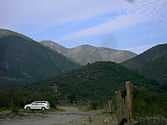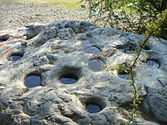Curacaví
| Curacaví | ||||
|---|---|---|---|---|
| City and Commune | ||||
|
Plaza de Armas in Curacaví | ||||
| ||||
| Coordinates: 33°24′S 71°09′W / 33.400°S 71.150°WCoordinates: 33°24′S 71°09′W / 33.400°S 71.150°W | ||||
| Country | Chile | |||
| Region | Santiago Metropolitan Region | |||
| Province | Melipilla Province | |||
| Government[1] [2] | ||||
| • Type | Municipality | |||
| • Alcalde | Guillermo Barros Echenique (UDI) | |||
| Area[3] | ||||
| • Total | 693.2 km2 (267.6 sq mi) | |||
| Population (2002 Census)[3] | ||||
| • Total | 24,298 | |||
| • Density | 35/km2 (91/sq mi) | |||
| • Urban | 15,645 | |||
| • Rural | 8,653 | |||
| Sex[3] | ||||
| • Men | 12,351 | |||
| • Women | 11,947 | |||
| Time zone | CLT [4] (UTC-4) | |||
| • Summer (DST) | CLST [5] (UTC-3) | |||
| Area code(s) | 56 + | |||
| Website | Municipality of Curacaví | |||
Curacaví is a city and commune in the Melipilla Province of central Chile's Santiago Metropolitan Region. It's climate is temperate Mediterranean with a long dry season, experiencing high temperatures in summer and low temperatures in winter. Curacavi is located on the Ruta 68 between the coastal conurbation of Vina del mar and Valparaiso and Santiago which has proved a popular home for expats working in Santiago.
Curacaví is a commune situated between the hills of the coastal mountain range in central Chile, located in the Metropolitan Region of Santiago, specifically in Melipilla Province, with an area of 693 km² and borders the following municipalities: Casablanca, Quilpué, Lampa, Pudahuel, Maipú, Padre Hurtado, Melipilla, and Maria Pinto.
Curacavi is integrated along with the communes of Talagante, Melipilla, Peñaflor, Isla de Maipo, Maria Pinto, El Monte, San Pedro and Alhué in the number 31 Electoral District and also belongs to the 7th Chilean Senate District (Santiago west). The commune covers five districts: Curacaví, Bustamante, Lo Prado, Zapata and Caren.
Rapid Expansion
Curacavi is now home to various exclusive gated communities called condominios. These large luxury developments range from 500 hectares upwards with each individual property starting at around 1 hectare. The develepoment of the condominios began in the 1990s but has accelerated dramatically in recent years. The area is therefore home to increasing numbers of wealthy Santiago commuters who are both Chilean and foreign. The momentum is largely due to fast transport links and a better quality of life in the face of Santiagos increasing pollution problems. Fast commuting times are now offered through the Ruta 68 and the Lo Prado tunnel which offers journeys times of 35 minutes to santiago.
Geography and climate
Immersed among the hills of the coastal mountain range, Curacaví occupies an area of 693.2 km2 (268 sq mi)[3] and borders the following communes: Casablanca, Quilpué, Lampa, Pudahuel, Maipú, Padre Hurtado, Melipilla, and María Pinto. The climate is mild Mediterranean with a long dry season with high temperatures in the summer and low temperatures in the winter.
Demographics
According to the 2002 census of the National Statistics Institute, Curacaví spans an area of 693.2 km2 (268 sq mi) and has 24,298 inhabitants (12,351 men and 11,947 women). Of these, 15,645 (64.4%) lived in urban areas and 8,653 (35.6%) in rural areas. The population grew by 27.5% (5,245 persons) between the 1992 and 2002 censuses.[3] There is a fast growing expat community in Curacavi
Notable people
- Juan Williams Rebolledo Commander-in-chief of the Chilean Navy at the beginning of the War of the Pacific.
- Rosamel del Valle - Avant-garde poet
Administration
As a commune, Curacaví is a third-level administrative division of Chile administered by a municipal council, headed by an alcalde who is directly elected every four years. The 2008-2012 alcalde is Guillermo Barros Echenique (UDI), and the council members are:[2]
- Juan Pablo Barros Basso (Independent)
- Cristián Galdames Santibáñez (PS)
- Paul Alvarado Muñoz (PDC)
- Cristian Enrique Hernandez Villanueva (UDI)
- Leonardo Bravo Gómez (PDC)
- Emilio Madrid Barros (UDI)
Within the electoral divisions of Chile, Curacaví is represented in the Chamber of Deputies by Denise Pascal (PS) and Gonzalo Uriarte (UDI) as part of the 31st electoral district, (together with Talagante, Peñaflor, El Monte, Isla de Maipo, Melipilla, María Pinto, Alhué, San Pedro and Padre Hurtado). The commune is represented in the Senate by Guido Girardi Lavín (PPD) and Jovino Novoa Vásquez (UDI) as part of the 7th senatorial constituency (Santiago-West).
Airport
Curacavi is home to a small airport situated by the motorway Ruta 68
Chicha
Curacavi is famous in Chile for its Chicha production. There is a popular Chilean song which sings about the Chicha from curacavi.
Kross Brewery
Curacavi is home to the Kross brand of craft beers.
Road from Santiago to Valparaiso
Curacaví is on the most used old horse trail between Valparaiso and Santiago which had been formed during the Inca period. Since 1553 it was called a the royal highway. The old road crossed Casablanca, the Zapata road and Curacavi finally entering Santiago on the road of San Pablo. The original royal highway was made between the years 1792 and 1797 however Ambrosio O'Higgins changed the old road by the current Lo Prado route.
Mercedes Canal
The Mercedes Canal ( Spanish: Canal de las Mercedes) , which irrigates the whole valley of Curacavi was built by Jose Manuel Balmaceda before becoming president. The Canal was started in 1854 and finished 30 years later with a total length of 120 km and a with a flow rate 10m³ / s .
Parish School
The first Parish School was built by the priest Don Eduardo Miles in 1885 which is still working and has done so almost without interruption educating much of the local population.
Gallery
| Photos of Curacaví | ||||||
|---|---|---|---|---|---|---|
|
References
- ↑ "Asociación Chilena de Municipalidades" (in Spanish). Retrieved 27 January 2011.
- ↑ 2.0 2.1 "Municipality of Curacaví" (in Spanish). Retrieved 27 January 2011.
- ↑ 3.0 3.1 3.2 3.3 3.4 "National Statistics Institute" (in Spanish). Retrieved 1 May 2010.
- ↑ "Chile Time". WorldTimeZones.org. Retrieved 2007-05-05.
- ↑ "Chile Summer Time". WorldTimeZones.org. Retrieved 2007-05-05.
External links
- (Spanish) Municipality of Curacaví
- Curacavi.com






